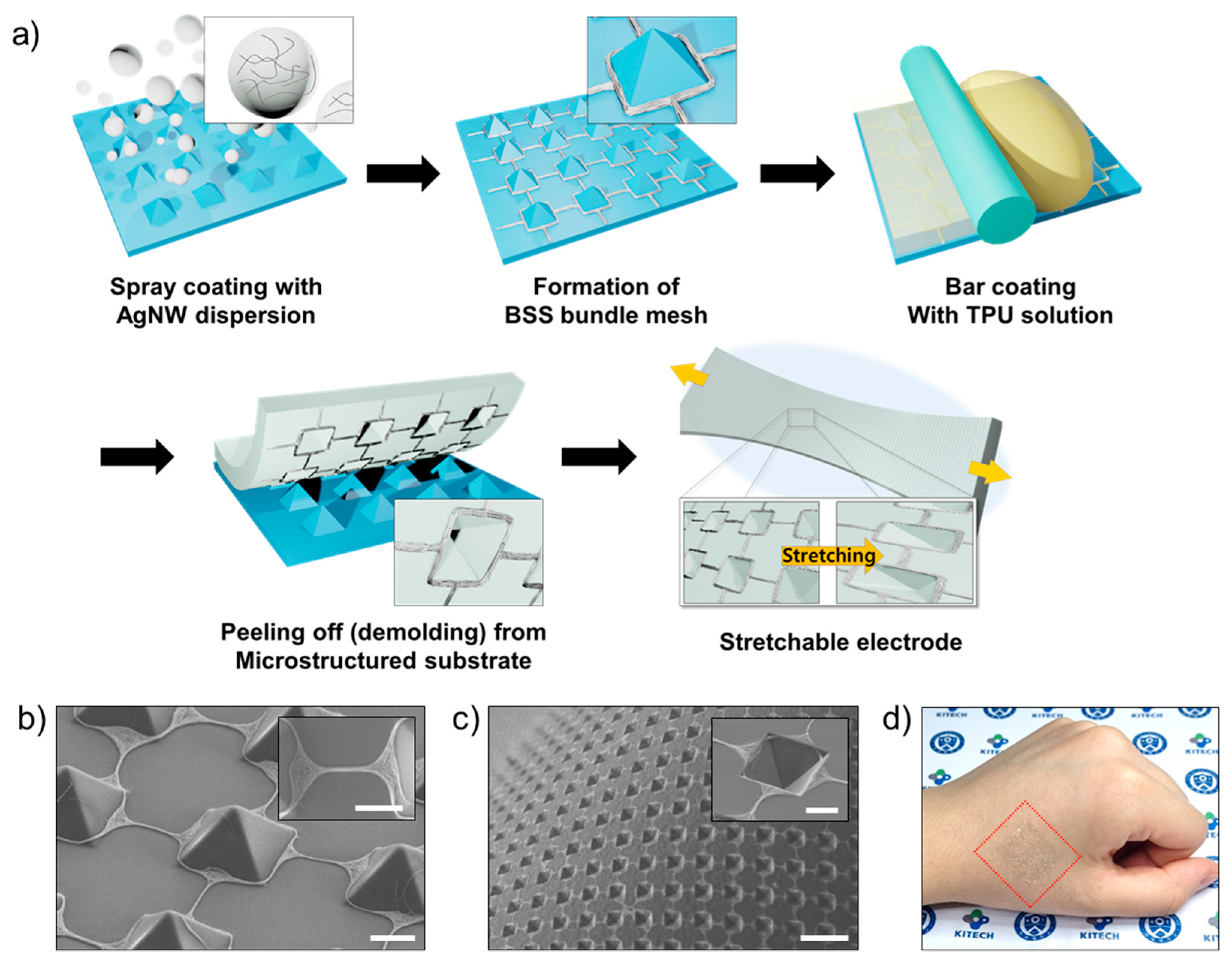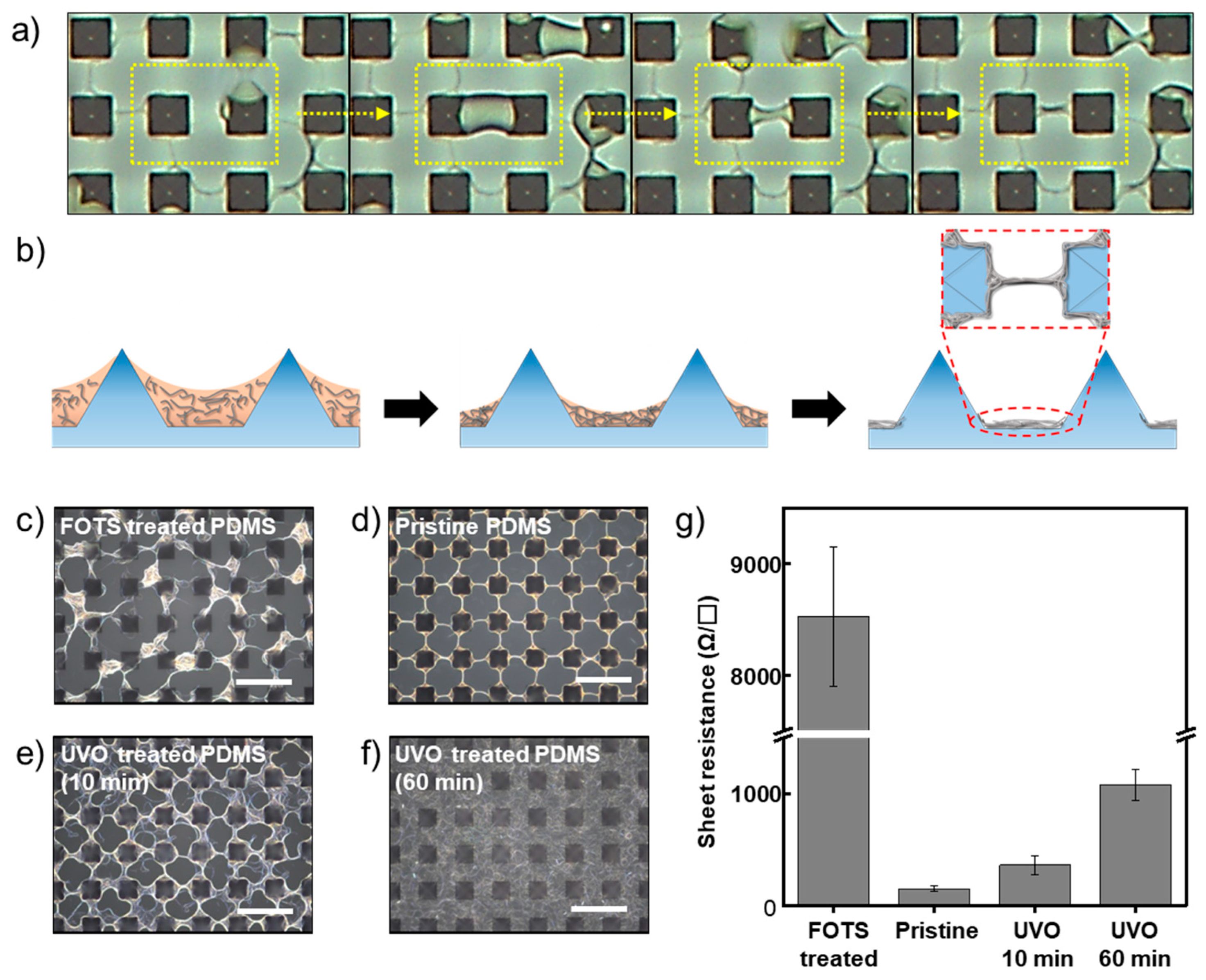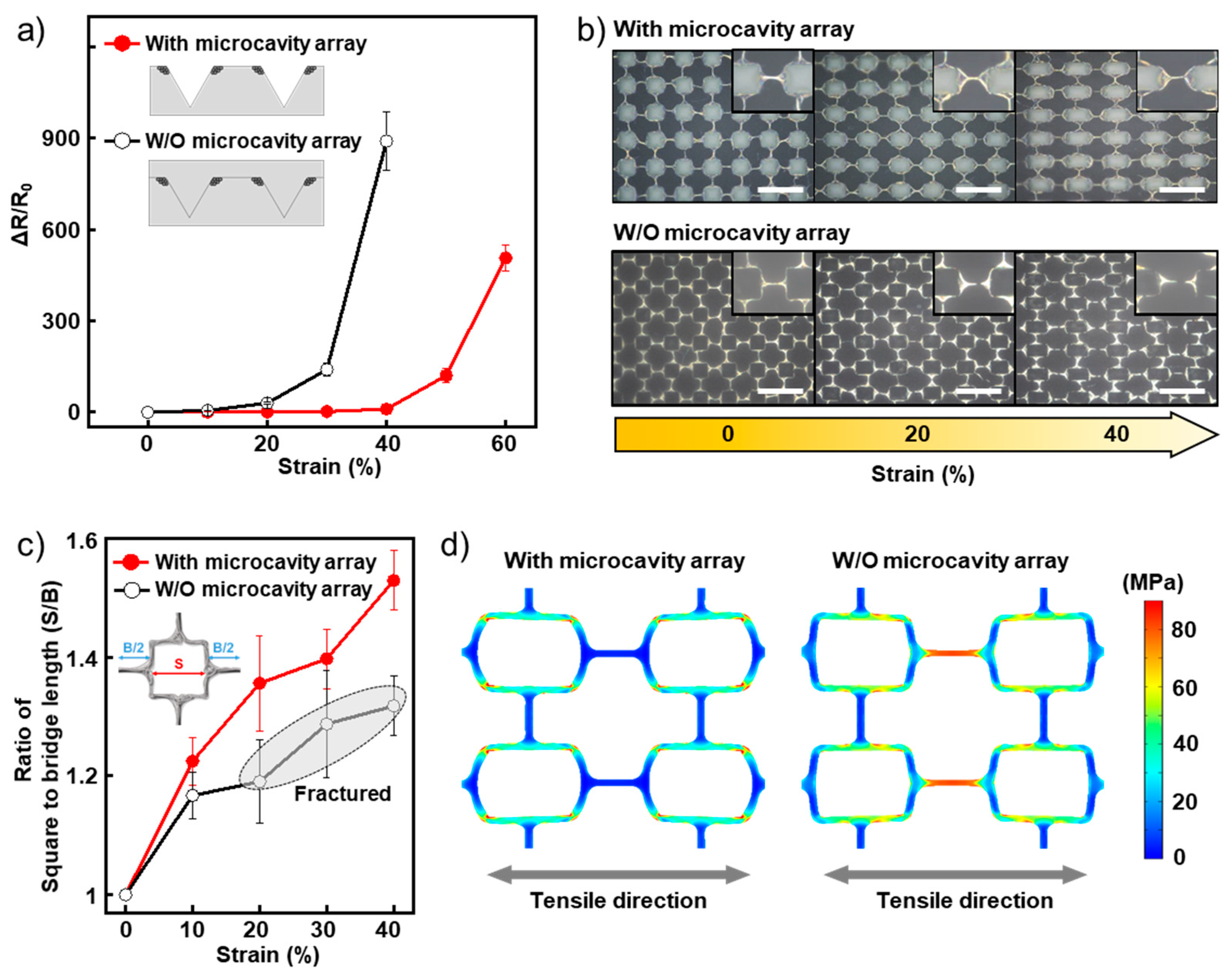Self-Patterned Stretchable Electrode Based on Silver Nanowire Bundle Mesh Developed by Liquid Bridge Evaporation
Abstract
:1. Introduction
2. Materials and Methods
3. Results and Discussion
4. Conclusions
Supplementary Materials
Author Contributions
Funding
Institutional Review Board Statement
Informed Consent Statement
Data Availability Statement
Conflicts of Interest
References
- Son, D.; Lee, J.; Qiao, S.; Ghaffari, R.; Kim, J.; Lee, J.E.; Song, C.; Kim, S.J.; Lee, D.J.; Jun, S.W.; et al. Multifunctional wearable devices for diagnosis and therapy of movement disorders. Nat. Nanotechnol. 2014, 9, 397. [Google Scholar] [CrossRef] [PubMed]
- Lee, H.; Choi, T.K.; Lee, Y.B.; Cho, H.R.; Ghaffari, R.; Wang, L.; Choi, H.J.; Chung, T.D.; Lu, N.; Hyeon, T.; et al. A graphene-based electrochemical device with thermoresponsive microneedles for diabetes monitoring and therapy. Nat. Nanotechnol. 2016, 11, 566. [Google Scholar] [CrossRef]
- Yokota, T.; Zalar, P.; Kaltenbrunner, M.; Jinno, H.; Matsuhisa, N.; Kitanosako, H.; Tachibana, Y.; Yukita, W.; Koizumi, M.; Someya, T. Ultraflexible organic photonic skin. Sci. Adv. 2016, 2, 1. [Google Scholar] [CrossRef] [PubMed] [Green Version]
- Kim, J.; Shim, H.J.; Yang, J.; Choi, M.K.; Kim, D.C.; Kim, J.; Hyeon, T.; Kim, D.-H. Ultrathin quantum dot display integrated with wearable electronics. Adv. Mater. 2017, 29, 1700217. [Google Scholar] [CrossRef] [PubMed]
- Choi, M.K.; Yang, J.; Kim, D.C.; Dai, Z.; Kim, J.; Seung, H.; Kale, V.S.; Sung, S.J.; Park, C.R.; Lu, N.; et al. Extremely vivid, highly transparent, and ultrathin quantum dot light-emitting diodes. Adv. Mater. 2018, 30, 1703279. [Google Scholar] [CrossRef]
- Xu, L.; Gutbrod, S.R.; Bonifas, A.P.; Su, Y.; Sulkin, M.S.; Lu, N.; Chung, H.-J.; Jang, K.-I.; Liu, Z.; Ying, M.; et al. 3D multifunctional integumentary membranes for spatiotemporal cardiac measurements and stimulation across the entire epicardium. Nat. Commun. 2014, 5, 3329. [Google Scholar] [CrossRef] [PubMed]
- Park, S.; Heo, S.W.; Lee, W.; Inoue, D.; Jiang, Z.; Yu, K.; Jinno, H.; Hashizume, D.; Sekino, M.; Yokota, T.; et al. Self-powered ultra-flexible electronics via nano-grating-patterned organic photovoltaics. Nature 2018, 561, 516. [Google Scholar] [CrossRef] [PubMed]
- Wonryung, L.; Shingo, K.; Masase, N.; Yasutoshi, J.; Itsuro, S.; Yusuke, I.; Tomoyuki, Y.; Masaki, S.; Malliaras, G.G.; Tomoyuki, Y.; et al. Nonthrombogenic, stretchable, active multielectrode array for electroanatomical mapping. Sci. Adv. 2018, 4, eaau2426. [Google Scholar]
- Kim, Y.; Kweon, O.Y.; Won, Y.; Oh, J.H. Deformable and Stretchable Electrodes for Soft Electronic Devices. Macromol. Res. 2019, 27, 625. [Google Scholar] [CrossRef]
- Matsuhisa, N.; Chen, X.; Bao, Z.; Someya, T. Materials and structural designs of stretchable conductors. Chem. Soc. Rev. 2019, 48, 2946. [Google Scholar] [CrossRef]
- Hu, M.; Cai, X.; Guo, Q.; Bian, B.; Zhang, T.; Yang, J. Direct pen writing of adhesive particle-free ultrahigh silver salt-loaded composite ink for stretchable circuits. ACS Nano 2016, 10, 396. [Google Scholar] [CrossRef] [PubMed]
- Yue, W.; Chenxin, Z.; Raphael, P.; Hongping, Y.; Lihua, J.; Shucheng, C.; Francisco, M.-L.; Franziska, L.; Jia, L.; Rabiah, L.N.; et al. A highly stretchable, transparent, and conductive polymer. Sci. Adv. 2017, 3, e1602076. [Google Scholar]
- Wang, J.; Cai, G.; Li, S.; Gao, D.; Xiong, J.; Lee, P.S. Printable superelastic conductors with extreme stretchability and robust cycling endurance enabled by liquid-metal particles. Adv. Mater. 2018, 30, 1706157. [Google Scholar] [CrossRef] [PubMed]
- Zhao, Y.; Huang, X. Mechanisms and materials of flexible and stretchable skin sensors. Micromachines 2017, 8, 69. [Google Scholar] [CrossRef] [Green Version]
- Zhang, C.; Khan, A.; Cai, J.; Liang, C.; Liu, Y.; Deng, J.; Huang, S.; Li, G.; Li, W.-D. Stretchable transparent electrodes with solution-processed regular metal mesh for an electroluminescent light-emitting film. ACS Appl. Mater. Interfaces 2018, 10, 21009. [Google Scholar] [CrossRef]
- Guo, C.F.; Liu, Q.; Wang, G.; Wang, Y.; Shi, Z.; Suo, Z.; Chu, C.-W.; Ren, Z. Fatigue-free, superstretchable, transparent, and biocompatible metal electrodes. Proc. Natl. Acad. Sci. USA 2015, 112, 12332–12337. [Google Scholar] [CrossRef] [PubMed] [Green Version]
- Ko, E.-H.; Kim, H.-J.; Lee, S.-M.; Kim, T.-W.; Kim, H.-K. Stretchable ag electrodes with mechanically tunable optical transmittance on wavy-patterned PDMS substrates. Sci. Rep. 2017, 7, 46739. [Google Scholar] [CrossRef]
- Tang, J.; Guo, H.; Zhao, M.; Yang, J.; Tsoukalas, D.; Zhang, B.; Liu, J.; Xue, C.; Zhang, W. Highly stretchable electrodes on wrinkled polydimethylsiloxane substrates. Sci. Rep. 2015, 5, 16527. [Google Scholar] [CrossRef] [Green Version]
- Xu, R.; Zverev, A.; Hung, A.; Shen, C.; Irie, L.; Ding, G.; Whitmeyer, M.; Ren, L.; Griffin, B.; Melcher, J.; et al. Kirigami-inspired, highly stretchable micro-supercapacitor patches fabricated by laser conversion and cutting. Microsyst. Nanoeng. 2018, 4, 36. [Google Scholar] [CrossRef]
- Bao, Y.; Hong, G.; Chen, Y.; Chen, J.; Chen, H.; Song, W.-L.; Fang, D. Customized kirigami electrodes for flexible and deformable lithium-ion batteries. ACS Appl. Mater. Interfaces 2020, 12, 780. [Google Scholar] [CrossRef] [PubMed]
- Hong, J.-Y.; Kim, W.; Choi, D.; Kong, J.; Park, H.S. Omnidirectionally stretchable and transparent graphene electrodes. ACS Nano 2016, 10, 9446. [Google Scholar] [CrossRef] [PubMed]
- Hong, S.; Lee, J.; Do, K.; Lee, M.; Kim, J.H.; Lee, S.; Kim, D.-H. Stretchable electrode based on laterally combed carbon nanotubes for wearable energy harvesting and storage devices. Adv. Funct. Mater. 2017, 27, 1704353. [Google Scholar] [CrossRef]
- Cho, S.; Kang, D.; Lee, H.; Kim, M.P.; Kang, S.; Shanker, R.; Ko, H. Highly stretchable sound-in-display electronics based on strain-insensitive metallic nanonetworks. Adv. Sci. 2021, 8, 2001647. [Google Scholar] [CrossRef] [PubMed]
- Liu, H.-S.; Pan, B.-C.; Liou, G.-S. Highly transparent AgNW/PDMS stretchable electrodes for elastomeric electrochromic devices. Nanoscale 2017, 9, 2633. [Google Scholar] [CrossRef] [PubMed]
- Kumar, A.; Shaikh, M.O.; Chuang, C.-H. Silver nanowire synthesis and strategies for fabricating transparent conducting electrodes. Nanomaterials 2021, 11, 693. [Google Scholar] [CrossRef] [PubMed]
- Liu, G.-S.; Liu, C.; Chen, H.-J.; Cao, W.; Qiu, J.-S.; Shieh, H.-P.D.; Yang, B.-R. Electrically robust silver nanowire patterns transferrable onto various substrates. Nanoscale 2016, 8, 5507. [Google Scholar] [CrossRef] [PubMed]
- Liang, J.; Li, L.; Chen, D.; Hajagos, T.; Ren, Z.; Chou, S.-Y.; Hu, W.; Pei, Q. Intrinsically stretchable and transparent thin-film transistors based on printable silver nanowires, carbon nanotubes and an elastomeric dielectric. Nat. Commun. 2015, 6, 7647. [Google Scholar] [CrossRef] [PubMed] [Green Version]
- Xiong, J.; Li, S.; Ye, Y.; Wang, J.; Qian, K.; Cui, P.; Gao, D.; Lin, M.-F.; Chen, T.; Lee, P.S. A deformable and highly robust ethyl cellulose transparent conductor with a scalable silver nanowires bundle micromesh. Adv. Mater. 2018, 30, 1802803. [Google Scholar] [CrossRef]
- Xiong, J.; Li, S.; Ciou, J.-H.; Chen, J.; Gao, D.; Wang, J.; Lee, P.S. A tailorable spray-assembly strategy of silver nanowires-bundle mesh for transferable high-performance transparent conductor. Adv. Funct. Mater. 2021, 31, 2006120. [Google Scholar] [CrossRef]
- Kim, C.H.; Lee, D.H.; Youn, J.; Lee, H.; Jeong, J. Simple and cost-effective microfabrication of flexible and stretchable electronics for wearable multi-functional electrophysio-logical monitoring. Sci. Rep. 2021, 11, 14823. [Google Scholar] [CrossRef]
- Niu, S.; Matsuhisa, N.; Beker, L.; Li, J.; Wang, S.; Wang, J.; Jiang, Y.; Yan, X.; Yun, Y.; Burnett, W.; et al. A wireless body area sensor network based on stretchable passive tags. Nat. Electron. 2019, 2, 361. [Google Scholar] [CrossRef]
- Zhu, J.; Hu, Z.; Song, C.; Yi, N.; Yu, Z.; Liu, Z.; Liu, S.; Wang, M.; Dexheimer, M.G.; Yang, J.; et al. Stretchable wideband dipole antennas and rectennas for RF energy harvesting. Mater. Today Phys. 2021, 18, 100377. [Google Scholar] [CrossRef] [PubMed]
- Bae, G.Y.; Han, J.T.; Lee, G.; Lee, S.; Kim, S.W.; Park, S.; Kwon, J.; Jung, S.; Cho, K. Pressure/temperature sensing bimodal electronic skin with stimulus discriminability and linear sensitivity. Adv. Mater. 2018, 30, 1803388. [Google Scholar] [CrossRef]
- Lee, G.; Lee, S.G.; Chung, Y.; Bae, G.Y.; Lee, S.; Ryu, S.; Cho, K. Omnidirectionally and highly stretchable conductive electrodes based on noncoplanar zigzag mesh silver nanowire arrays. Adv. Electron. Mater. 2016, 2, 1600158. [Google Scholar] [CrossRef]
- Wu, Y.; Su, B.; Jiang, L. Smartly aligning nanowires by a stretching strategy and their application as encoded sensors. ACS Nano 2012, 6, 9005. [Google Scholar] [CrossRef] [PubMed]
- Vakarelski, I.U.; Chan, D.Y.C.; Nonoguchi, T.; Shinto, H.; Higashitani, K. Assembly of gold nanoparticles into microwire networks induced by drying liquid bridges. Phys. Rev. Lett. 2009, 102, 58303. [Google Scholar] [CrossRef] [Green Version]
- Vakarelski, I.U.; Kwek, J.W.; Tang, X.; O’Shea, S.J.; Chan, D.Y.C. Particulate templates and ordered liquid bridge networks in evaporative lithography. Langmuir 2009, 25, 13311. [Google Scholar] [CrossRef] [PubMed]
- Lee, G.; Bae, G.Y.; Son, J.H.; Lee, S.; Kim, S.W.; Kim, D.; Lee, S.G.; Cho, K. User-interactive thermotherapeutic electronic skin based on stretchable thermochromic strain sensor. Adv. Sci. 2020, 7, 2001184. [Google Scholar] [CrossRef] [PubMed]
- Yan, C.; Su, B.; Shi, Y.; Jiang, L. Liquid bridge induced assembly (LBIA) strategy: Controllable one-dimensional patterning from small molecules to macro-molecules and nanomaterials. Nano Today 2019, 25, 13. [Google Scholar] [CrossRef]




Publisher’s Note: MDPI stays neutral with regard to jurisdictional claims in published maps and institutional affiliations. |
© 2021 by the authors. Licensee MDPI, Basel, Switzerland. This article is an open access article distributed under the terms and conditions of the Creative Commons Attribution (CC BY) license (https://creativecommons.org/licenses/by/4.0/).
Share and Cite
An, E.Y.; Lee, S.; Lee, S.G.; Lee, E.; Baek, J.J.; Shin, G.; Choi, K.H.; Cho, J.H.; Bae, G.Y. Self-Patterned Stretchable Electrode Based on Silver Nanowire Bundle Mesh Developed by Liquid Bridge Evaporation. Nanomaterials 2021, 11, 2865. https://doi.org/10.3390/nano11112865
An EY, Lee S, Lee SG, Lee E, Baek JJ, Shin G, Choi KH, Cho JH, Bae GY. Self-Patterned Stretchable Electrode Based on Silver Nanowire Bundle Mesh Developed by Liquid Bridge Evaporation. Nanomaterials. 2021; 11(11):2865. https://doi.org/10.3390/nano11112865
Chicago/Turabian StyleAn, Eun Young, Siyoung Lee, Seung Goo Lee, Eunho Lee, Jeong Ju Baek, Gyojic Shin, Kyung Ho Choi, Jeong Ho Cho, and Geun Yeol Bae. 2021. "Self-Patterned Stretchable Electrode Based on Silver Nanowire Bundle Mesh Developed by Liquid Bridge Evaporation" Nanomaterials 11, no. 11: 2865. https://doi.org/10.3390/nano11112865
APA StyleAn, E. Y., Lee, S., Lee, S. G., Lee, E., Baek, J. J., Shin, G., Choi, K. H., Cho, J. H., & Bae, G. Y. (2021). Self-Patterned Stretchable Electrode Based on Silver Nanowire Bundle Mesh Developed by Liquid Bridge Evaporation. Nanomaterials, 11(11), 2865. https://doi.org/10.3390/nano11112865






